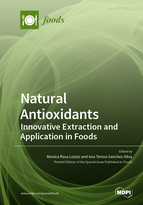Natural Antioxidants: Innovative Extraction and Application in Foods
A special issue of Foods (ISSN 2304-8158). This special issue belongs to the section "Food Physics and (Bio)Chemistry".
Deadline for manuscript submissions: closed (1 September 2020) | Viewed by 47808
Special Issue Editors
Interests: food science technology; bioactives from food by-products; evaluation of shelf-life; development of functional foods
Special Issues, Collections and Topics in MDPI journals
Interests: food and food packaging analysis; food bioactives; food contaminants; mycotoxins; food packaging migration; development and validation of analytical methods for the determination of food components and food contaminants; mass spectrometry applied to food analysis; development of active packaging with antioxidant properties; edible packaging
Special Issues, Collections and Topics in MDPI journals
Special Issue Information
Dear Colleagues,
Research has devoted great attention to the study of the biological properties of plants, animal products, microorganisms, marine species, and fungi, among others, often driven by the need to discover new medicines. Many times, in order to enhance biological activities, extracts are prepared. One of the most well studied biological activities is antioxidant capacity, related to anticancer and anti-ageing properties, the improvement of immune function, and protection against cardiovascular diseases and neurological disorders. Moreover, in foods, antioxidants allow for delayed oxidation onset and enhancing food shelf life.
The changes in lifestyle patterns and world population growth demand safe, nutritious, flavourful, colourful, affordable, and convenient food, and the high-quality standards have increased the use of food additives, especially antioxidants. The effects of some food additives on human health are controversial, and synthetic food additives are often associated with potential public health risk. Therefore, there is a tendency towards substituting synthetic food additives with natural compounds.
We are organizing a Special Issue entitled “Natural Antioxidants: Innovative Extraction and Application in Foods” in the Foods (ISSN 2304-8158; CODEN: FOODBV), https://0-www-mdpi-com.brum.beds.ac.uk/journal/foods). With your distinguished expertise in this area, we would like to invite you to submit a paper to this Special Issue. The Special Issue focuses on the application of innovative extraction techniques for the recovery of natural antioxidants from foods, and their possible application in food industries.
Prof. Monica Rosa Loizzo
Dr. Ana Sanches Silva
Guest Editors
Manuscript Submission Information
Manuscripts should be submitted online at www.mdpi.com by registering and logging in to this website. Once you are registered, click here to go to the submission form. Manuscripts can be submitted until the deadline. All submissions that pass pre-check are peer-reviewed. Accepted papers will be published continuously in the journal (as soon as accepted) and will be listed together on the special issue website. Research articles, review articles as well as short communications are invited. For planned papers, a title and short abstract (about 100 words) can be sent to the Editorial Office for announcement on this website.
Submitted manuscripts should not have been published previously, nor be under consideration for publication elsewhere (except conference proceedings papers). All manuscripts are thoroughly refereed through a single-blind peer-review process. A guide for authors and other relevant information for submission of manuscripts is available on the Instructions for Authors page. Foods is an international peer-reviewed open access semimonthly journal published by MDPI.
Please visit the Instructions for Authors page before submitting a manuscript. The Article Processing Charge (APC) for publication in this open access journal is 2900 CHF (Swiss Francs). Submitted papers should be well formatted and use good English. Authors may use MDPI's English editing service prior to publication or during author revisions.
Keywords
- Antioxidants
- Extraction
- Incorporation of antioxidant in food matrix








